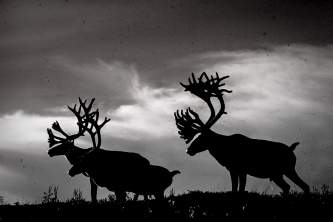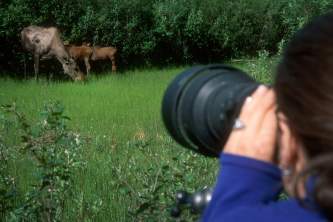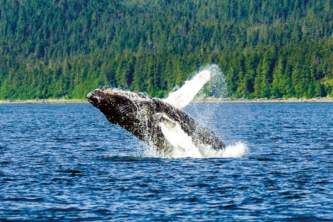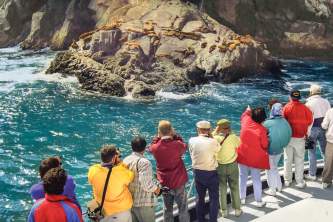Alaska’s Best Whale Watching Spots
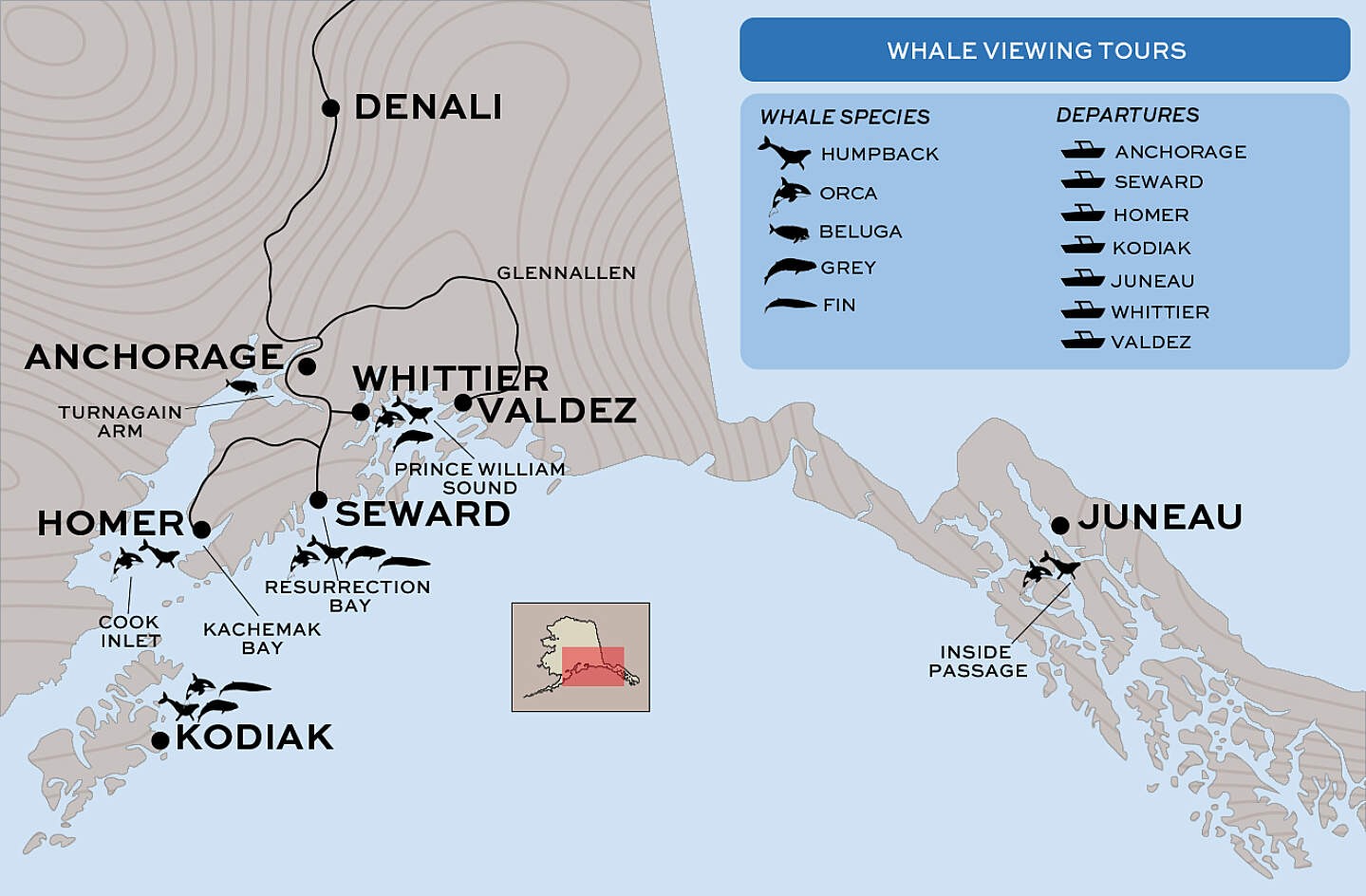
Seeing a colossal humpback whale take its deep, sounding dive with flukes flipping up above the surface—or a killer whale leap in a spectacular, wave-crashing breach—can be one of the most breath-taking moments of your Alaska experience. But you must first go to where the whales are swimming.
Most Reliable Way: Get Out on a Boat
Fortunately, getting out on a boat is easy to do in Alaska! Most of our coastal towns feature many excellent tour operators, some of them world-class with naturalists, refreshments and other amenities on board.
Gray whales return to Alaska the first week of March. From April through September is prime whale watching for most species.
What Might You See?
- Humpback whales. Coastal Alaska serves as feeding grounds for a population of 10,000 humpback whales that breed in Hawaii during the winter. Up to 60-feet long and 40 tons in weight, humpbacks are fabled for singing eerie and intricate “songs” while on their trans-Pacific journeys. During summer, they can be found almost everywhere along Alaska’s coast, from Southeast to the Bering Sea, including Gulf of Alaska areas close to Anchorage and Alaska’s road system.
- Gray whales. Thousands of gray whales swim from breeding areas in Baja California to summer feeding areas in the Arctic during one of the world’s longest mammal migrations, an incredible 11,000-mile round trip. As long as a school bus and weighing 30 tons, these whales tend to follow Alaska’s outer coast—swimming cape to cape across the mouths of fiords and bays. Their outbound spring trip skirts the state in April and June, with the biggest concentrations passing the Kenai Peninsula and Kodiak areas during May.
- Killer whales. Perhaps the ocean’s most intelligent predator, killer whales haunt Alaska’s bays and inlets all year long. These 10-ton animals usually occur in two types near the coast, but both have the same iconic, black-and-white appearance. You’re most likely to see the noisy and sometimes gregarious pods known as residents, which target fish (especially salmon!) More elusive are the quiet and secretive marine mammal hunters known as transients.
- Beluga whales. Cook Inlet near Anchorage is home to a small and completely isolated population of these white fish-eating whales. (Beluga calves are gray-blue.) Numbering about 312 animals, these belugas are listed as critically endangered, so seeing them is a privilege. Several different and much larger populations of belugas spend summers in Bristol Bay and Arctic areas.
- Other large whales and cetaceans. Many other species of whales, porpoises and dolphins meander into Alaska’s near-shore waters. Most common are probably the black-and-white Dall’s porpoises—playful animals that will cavort and ride bow waves of boats underway. Also be alert for minke and fin whales, plus Pacific white-sided dolphins and harbor porpoises.
- For a complete list of whales, dolphins and porpoises that can show up in Alaska’s ocean, check out the marine mammal list of the Alaska Wildlife Notebook Series by ADFG.
List Of Viewing Locations in Alaska
Show Map
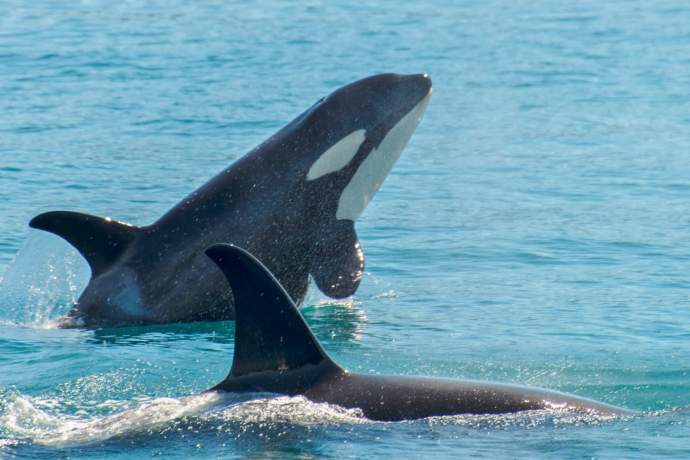
Resurrection Bay (Seward)
This 970-foot-deep fjord extending south from Seward toward the Gulf of Alaska and the Kenai Fjords National Park may be one of the most reliable places to view marine wildlife in the world. Its pristine, food-rich waters are only a few miles from the open ocean, offering extraordinary access to the productive outer coast. Whales can sometimes be seen from the waterfront park or off the beach at Lowell Point south of town. But best bet will be to take a tour boat deep into the bay. There visitors will see feeding humpback whales on most summer days, and have a good chance of encountering pods of killer whales, especially once salmon have begun schooling for spawning runs. During calm weather in the outer bay, where real ocean swells sometimes roll in from the Gulf, it can be a total bird-and-mammal show, with Alaska’s most common marine species active and easy to see. (Sea lions, seals and sea otters also abound.) In April and May, gray whales pass the mouth of the bay on their epic spring migration to the Arctic. Many tour operators offer partial and full-day trips, with captains often maintaining radio contact with each other to share intel about sightings.
Other Tips
Visit the Alaska Sealife Center, a public aquarium and research facility on the shore of Resurrection Bay just south of downtown Seward. While not focused specifically on whales, the center staff recently rehabbed a baby beluga whale to health and its scientists sometimes study whales. Its displays and habitats open a vivid window (literally) on Alaska’s marine world.
Getting There
Seward is one of Alaska’s most popular destinations, a friendly small town with full services and gobs of things to do. Located on the Kenai Peninsula about 120 miles south of Anchorage at the end of the Seward Highway.
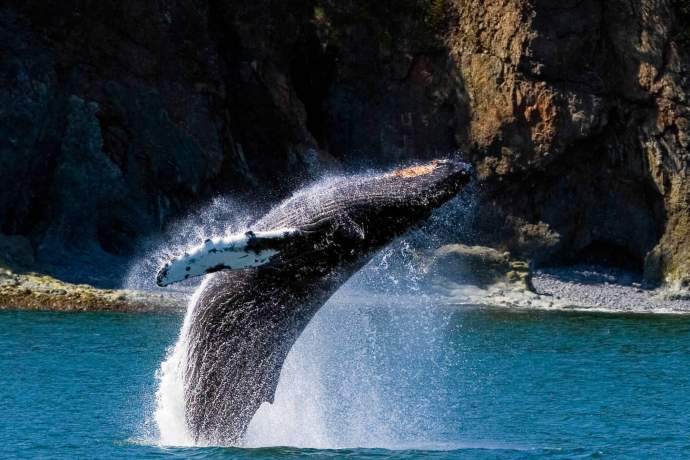
Prince William Sound (Whittier & Valdez)
Humpback whales gallivant among the fiords and open bays of Prince William Sound, most often as lone animals sounding with flukes up as they dive in pursuit of the Sound’s rich concentrations of fish. It’s not uncommon to see cow-and-calf pairs, sometimes feeding and sometimes lolling on the surface in rest. Pods of killer whales will roll and thrash the water as they feed on schooling salmon. Dall’s porpoises cruise around, sometimes playing on the wake or bow wave of boats. For best results, take a glacier or wildlife cruise out of Whittier or Valdez—there are many tour operators and venders in both towns. Outside of Whittier, good prospects for whales will begin about 10 miles out in Wells Passage or 14 miles out in Blackstone Bay. From Valdez, cruises to Columbia and Meares glaciers almost always cross paths with whales and porpoises doing their summer thing. If traveling on a state ferry between the two towns, or to Cordova, keep watch for distant white puffs of whale breath, and you’ll know “thar she blows!”
Getting There
Whittier is 55 miles southeast of Anchorage beyond the head of Turnagain Arm. Take the Seward Highway to Portage Glacier Road, head to Portage Lake and then drive through the Anton Anderson Memorial Tunnel to Whittier on Passage Canal.
Valdez is at the terminus of the Richardson Highway, about 300 miles from Anchorage and 360 miles from Fairbanks.
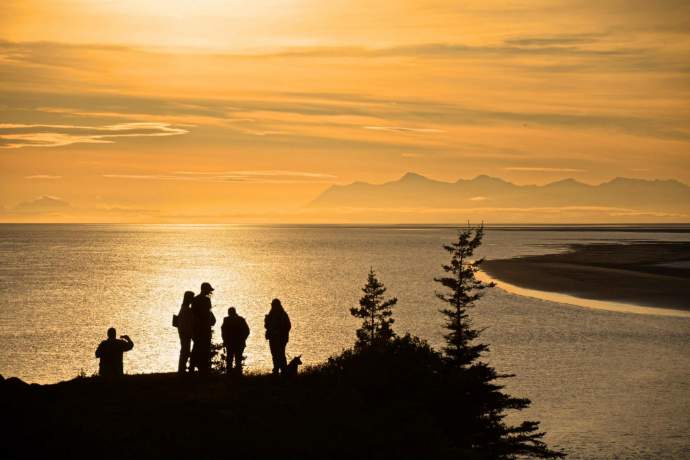
Turnagain Arm (Near Anchorage)
The endangered beluga whales of upper Cook Inlet near Anchorage follow the runs of salmon and hooligan—and are most often seen just before and after high tides in Turnagain Arm along the Seward Highway. Best bet: During big falling tides between mid-July and September, watch for belugas exiting the arm down a channel that parallels the highway between Girdwood and Bird Point Wayside. Watch for the winking white of their backs arching from the water as they breathe (sometimes difficult to distinguish from white caps.) It’s not uncommon for them to swim only yards off the rocks. Listen and you may hear them chirping and chattering as they pass (old-time whalers nicknamed belugas “sea canaries.”) Aptly named Beluga Point overlooks an expanse with another chance to see them on the move. Belugas will also occasionally swim past Anchorage beaches along Knik Arm and through the channel between Point Campbell and Fire Island, so it’s always good to be alert when visiting Kincaid Park or the Tony Knowles Coastal Trail during high tide. Likewise, if traveling to Hope on the northern coast of the Kenai Peninsula opposite from Anchorage, check out Hope Highway pullouts after the tide has turned. Scientists also say the belugas often work the mouths of the Susitna River beyond Knik Arm west of Anchorage and the Chickaloon River on the northern Kenai Peninsula—both remote and difficult-to-reach spots.
Getting There:
The Seward Highway runs southeast of Anchorage along Turnagain Arm for almost 50 miles. Beluga Point is at Mile 110.4, and Bird Point Wayside is at Mile 96. The most productive pullouts for whale watching are where the highway runs right along the shore between Bird Point and Girdwood (Mile 90.) The 18-mile Hope Highway cuts off the Seward in the Kenai Mountains at Mile 54 (about 71 miles south of Anchorage.) The last 10 miles or so parallel Turnagain Arm.
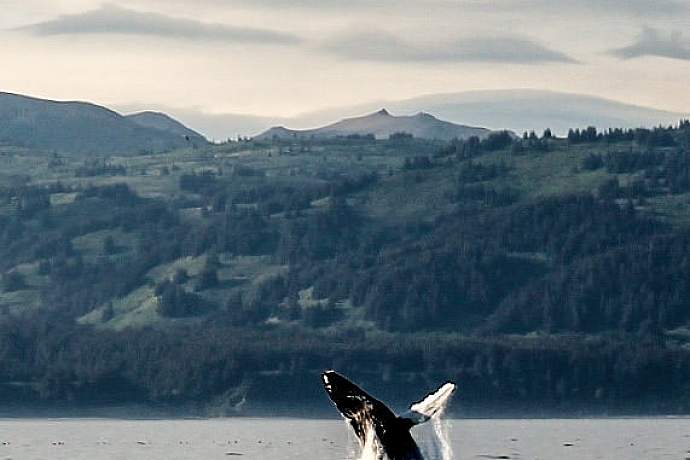
Homer
Whales and other marine mammals proliferate in Kachemak Bay and Lower Cook Inlet off this end-of-the-highway community, though perhaps not in the concentrations found in some other places like Resurrection Bay. Regular visitors are humpback whales on their summer-long binge, and killer whales in pursuit of salmon. Both species work the rich coastline on the southern shore of the bay, from Halibut Cove to the Herring Islands area. Further out, where the bay opens into vast Cook Inlet with the storybook cone of Augustine Volcano shimmering on the horizon, chances increase for a rare encounter with one of the giant baleen whales. Fin whales occasionally enter the inlet, and tour operators have even reported seeing blue whales far offshore. Along with its whales, of course, Kachemak Bay and the surrounding region are simply teeming with all kinds of marine wildlife—birds, sea otters, seals, dolphins and porpoises, sea lions. Many tour operators motor from the Homer Spit—which reaches several miles into the bay—directly to the noisy rookery on Gull Island with 20,000 nesting seabirds and then proceed from there to the fiords and headlands along the Kachemak Bay State Park. Whales are also regular seen by people heading out on deep-sea fishing charters for halibut and lincod.
Other Tips
- For a unique 180-degree panorama of Kachemak Bay and Cook Inlet, stop at the Baycrest Hill overlook at the top of the bluff just before your descent into Homer. On calm days, you will see sea otters speckling the waters, with congregations of humpbacks sometimes in view. This perch about 600 feet above the sea features the glittering spit at night, boat traffic and the wakes of marine mammals during the day, with snowy mountains spanning an endless horizon. It may be one of the greatest views in Alaska. Sterling Highway Mile 169.6, about 3 miles out of town.
- Don’t miss the Islands and Oceans Visitor Center, headquarters of the federal Alaska Maritime Wildlife Refuge. You’ll find displays, programs and information about whales and other marine creatures inhabiting the vast marine refuge, extending from Cook Inlet to the far end of the Aleutian Chain. With trails to the beach. Right as you enter town, at 95 Sterling Highway.
- Check out our guide to Homer tours of all kinds.
Getting There:
Homer is one of Alaska’s most popular summer destinations, located at the end of the U.S. road system at the southern end the Sterling Highway on the Kenai Peninsula, about 220 miles from Anchorage and 80 miles south of Kenai. The fleet of tour operators and charter boats dock in the harbor at the end of the 4.5-mile Homer Spit. During summer, the spit enjoys a carnival-like atmosphere and is known for its seafood, camping and fresh ocean air. It’s like taking a trip to an island in the middle of the bay.
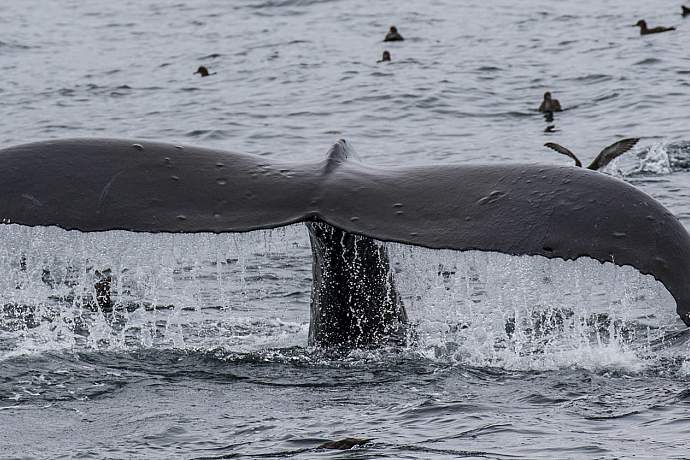
Kodiak
With humpback whales all summer, and gray whales in the spring, this commercial fishing town on an island south of Cook Inlet in the Gulf of Alaska may be the state’s best kept whale-watching secret. Though most people associate Alaska’s “Emerald Isle” with its thriving population of large brown bears and hundreds of salmon runs, the community’s geography allows tour operators direct access to the deep ocean along a rugged and interesting coastline. Gray whales pass close by the island during their spring migration, often visible from beaches and headlands. During summer, humpback and fin whales chase schooling fish. People also report seeing foraging sei and menke whales, and killer whales pursuing seals and sea lions. To be sure, you are more likely go to Kodiak with goal to see bears, go fishing and enjoy one of America’s busiest fishing ports. But keep whales and other marine mammals on your itinerary.
Other Tips
- Check out the Kodiak Wildlife Viewing Guide from ADFG, especially for its listings of shore-based sites with whale-watching potential.
- Whalefest Kodiak celebrates the return of gray whales every April with two weeks of activities, science talks by whale biologists, and whale-watching excursions.
Getting There:
Kodiak Island is about 120 miles south of Homer (about 250 miles air miles south of Anchorage.) Booking passage on a ferry through the Alaska Marine Highway System from Homer is a great adventure, but will take about 10 hours one way. Many visitors fly directly from Anchorage (about an hour on a jet) or take an airplane from Homer.
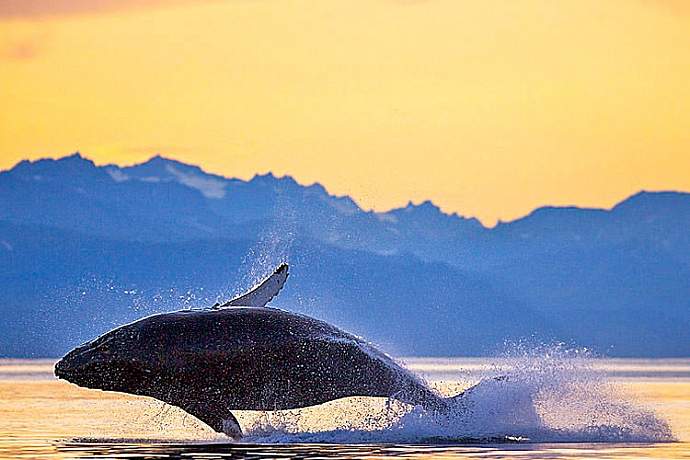
Inside Passage (Juneau and Other SE Alaska Towns)
Welcome to the summer paradise for humpback whales! These big baleen animals with an eerie song in their gullets descend on the passages and fiords of Southeast Alaska every summer in such high concentrations that many tour operators offer a money-back guarantee if none are seen. As the myriad bays and channels bloom with krill and feeder fish, the whales converge to feast around the clock. This is the realm of extraordinary displays—where one humpback will trap and concentrate fish with bubble streams from its blowhole while other whales explode from the sea with mouths yawning wide to scoop up the bounty. This “bubble net” feeding sometimes brings together a half dozen whales at once. Almost every day, lone humpbacks will cruise through practically every single sound and bight. Killer whales also work these waters, usually appearing in pods of fish-eating residents. With wider ranges, killer whales will be a bit more rare. The other Alaskan marine mammals proliferate, too—Dall’s porpoise, harbor seals, Steller sea lions and sea otters around.
Southeast Alaska Tips:
- Point Aldolphus in Icy Strait—about 50 miles west of Juneau—may draw the most intense concentration of humpback whales in Southeast Alaska. These waters lie between the Chichigoff Island village of Hoonah and mainland Gustavus (headquarters of Glacier Bay National Park.) Here the nutrient rich waters of the North Pacific mingle with outflow from Glacier Bay and currents from other passages, creating a particularly dense concentration of food for whales and other marine mammals.
- Cruise ships will book your whale-watching trip for you, but you can often get a better price by contacting tour operators directly. Checking in person with tour companies in the early afternoon for vacancies on a same-day trip can sometimes conjure up a bargain discount.
- Independent travelers should consider booking tours on days when no cruise ship is docked. Crowds may be smaller, and you might find better prices.
- Here are our recommended whale watching tours in Juneau, Ketchikan, and Hoonah / Icy Strait Point.
Getting There:
- You don’t go to Southeast Alaska by accident. Except for Skagway and Haines, all communities are off the road system and must be accessed by boat or air. If you are traveling on a cruise, marine mammal tours will be on the menu at every port, and the bridge will almost certainly announce sightings while underway. If you are traveling independently, you will find dozens of tour choices in every town.
- Juneau—Alaska’s capital city—may be the most common gateway town into Southeast Alaska, with nonstop flights from Seattle and Anchorage. More than a dozen other SE communities are serviced by commercial flights, sometimes requiring multiple stops or taking a leg on a commuter airplane or a seaplane. The most common destinations are probably Ketchikan, Sitka and Gustavus.
- For another travel option that actually offers potential whale watching while underway, book a trip on the Alaska Marine Highway System. The most popular mode among locals, these big, blue ferries dock at 14 different communities. Plus, you can find connections to Skagway and Haines on the road system, Yakutat and Seward on the Gulf of Alaska, and Prince Rupert and Bellingham to the south.
- Traveling to small Southeast Alaska communities
- Guide to in-state airline travel
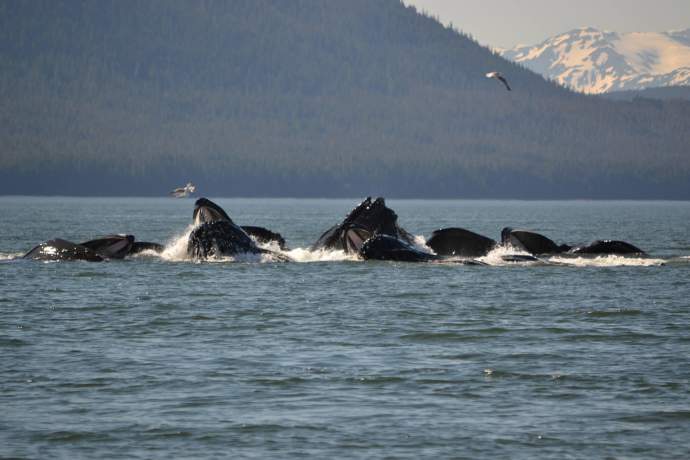
Whale Watching Tips
- If you’re prone to sea-sickness, chose to tour aboard a larger rather than smaller vessel. The bigger the boat, the calmer the ride. Under most conditions, the double-decker tour boats will feel solid, with little perceived motion. See more information on how to avoid motion sickness on a cruise here.
- If sea-sickness is not an issue, or it’s calm, don’t be shy away from a charter aboard a small boat with room for four to six. Many of these “sixpack” operators are local residents with expert knowledge of the best places to go. And small boats, with their shallower drafts, can sneak into bays and channels off limits to the big vessels.
- Carry good glass with a cleaning cloth. Binoculars will extend your perception of distant observations, and give you intimate detail on closer animals.
- If you’re on the waterfront or in the harbor, ask people returning from charters and outings whether they’ve seen any activity that day. In Alaska, everybody shares whale intel. And sometimes whales are spouting just around the corner!
- Don’t hang up on the term “whale watching.” Guides will try to show you everything they can find over the course of the trip—marine mammals, birds and rookeries, mountain scenes, glaciers. Many fishing charters offer wildlife viewing, too.

